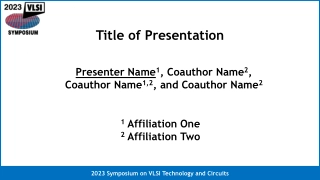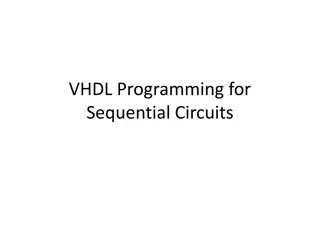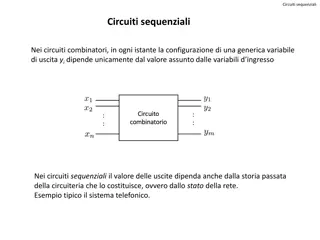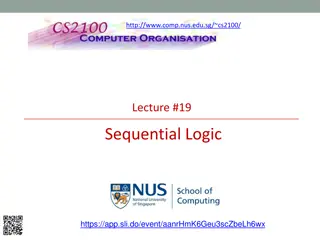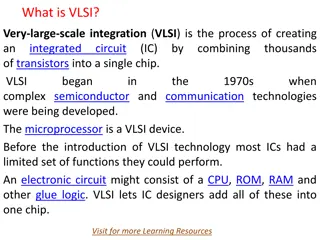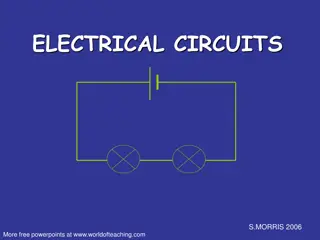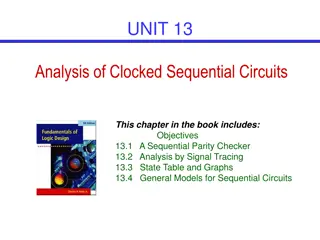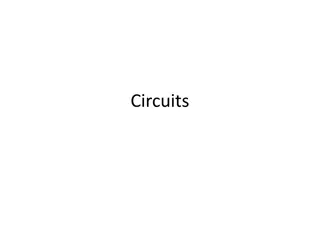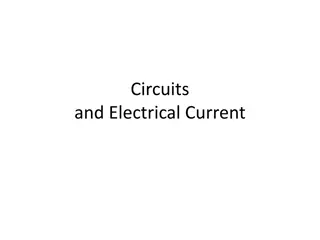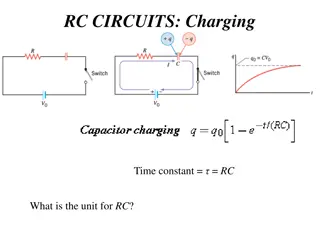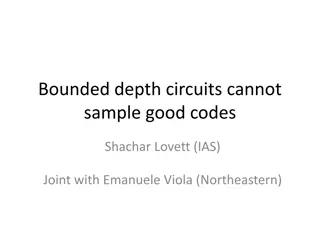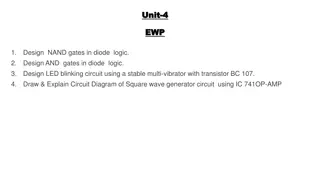Introduction to VLSI Design and Sequential Circuits
This content introduces the basics of VLSI design and sequential circuits, covering topics such as memory elements, latches vs. registers, timing definitions, and standard memory elements. It elaborates on the functionality of sequential circuits and explains concepts like bistable logic devices, multivibrators, and clocked memory elements. The provided images visually represent these concepts and help in understanding the fundamental principles of VLSI design.
Download Presentation

Please find below an Image/Link to download the presentation.
The content on the website is provided AS IS for your information and personal use only. It may not be sold, licensed, or shared on other websites without obtaining consent from the author.If you encounter any issues during the download, it is possible that the publisher has removed the file from their server.
You are allowed to download the files provided on this website for personal or commercial use, subject to the condition that they are used lawfully. All files are the property of their respective owners.
The content on the website is provided AS IS for your information and personal use only. It may not be sold, licensed, or shared on other websites without obtaining consent from the author.
E N D
Presentation Transcript
ECE 424 Introduction to VLSI Design Emre Yengel Department of Electrical and Communication Engineering Fall 2014
Introduction Sequential circuit o Output depends not just on present inputs (as in combinational circuit), but on past sequence of inputs Stores bits, also known as having state o Simple example: a circuit that counts up in binary Inputs Outputs COMBINATIONAL LOGIC Current State Next state Registers Q D CLK A sequential circuit consists of a feedback path, and employs some memory elements.
Introduction Flight attendant call button Press call: light turns on Stays on after button released Press cancel: light turns off Logic gate circuit to implement this? Call Blue light button Bit Storage Cancel button 1. Call button pressed light turns on Blue light Call button Bit a a Storage Cancel button 2. Call button released light stays on Q Call Cancel a Call Blue light button Bit Doesn t work. Q=1 when Call=1, but doesn t stay 1 when Call returns to 0 Need some form of feedback in the circuit Storage Cancel button 3. Cancel button pressed light turns off
Memory Elements There are two types of sequential circuits: o synchronous: outputs change only at specific time o asynchronous: outputs change at any time Multivibrator: a class of sequential circuits. They can be: bistable (2 stable states) monostable or one-shot (1 stable state) astable (no stable state) Bistable logic devices: latches and registers a latch is level sensitive a register is edge-triggered Many books call edge-triggered elements flip-flops.
Standard Memory Elements Memory element with clock. Q Memory element command stored value clock Clock is usually a square wave. Positive pulses Positive edges Negative edges
Timing Definitions Register D t Q tsu thold D DATA STABLE CLK t tc2 q Q DATA STABLE t setup time (tsu) hold time (thold) propagation delay (tc-q)
Latches vs Registers Latch stores data when clock is low or high Register stores data when clock rises D Q D Q Clk Clk Clk Clk D D Q Q
Static Latches and Registers: Bistability Principle Vi2 Vo1 Vi1 Vo2 A When the gain of the inverter in the transient region is larger than 1, only A and B are stable operation points, and C is a metastable operation point. Vi2= Vo1 C B Vi1= Vo2
Bistability Principle Gain should be larger than 1 in the transition region
SR Latches SR latch S (set) Does the circuit to the right, with cross-coupled NOR gates, do what we want? Q R (reset) S=0 S=1 S=0 S=0 t t t t Recall 1 1 0 0 0 0 0 0 1 1 1 1 X 1 1 0 0 0 1 1 0 0 Q Q Q Q R=1 R=0 R=0 R=0 1 0 1 0 1 0 1 0 S R a t Q
SR Latches Characteristics table for active-high input S-R latch (also known as NOR gate latch): S R Q Q' No change. Latch remained in present state. Latch SET. Latch RESET. Invalid condition. 0 0 NC NC S Q 1 0 1 0 1 1 1 0 0 0 1 0 R Q' Characteristics table for active-low input S'-R' latch (also known as NAND gate latch): S' R' Q Q' No change. Latch remained in present state. Latch SET. Latch RESET. Invalid condition. 1 1 NC NC S Q 0 1 0 1 0 0 1 0 1 0 1 1 R Q'
SR Latches Problem If S=1 and R=1 simultaneously, we don t know what value Q will take 1 S 0 1 R 0 1 t 0 1 Q 0 1 Q may oscillate. Then, because one path will be slightly longer than the other, Q will eventually settle to 1 or 0 but we don t know which. t 0 1 Q0
SR Latches Problem not just one of a user pressing two buttons at same time Can also occur even if SR inputs come from a circuit that supposedly never sets S=1 and R=1 at same time But does, due to different delays of different paths Arbitrary circuit SR latch S X Q R Y The longer path from X to R than to S causes SR=11 for short time could be long enough to cause oscillation
Level Sensitive SR Latches Add enable input C as shown Only let S and R change when C=0 Enure circuit in front of SR never sets SR=11, except briefly due to path delays Change C to 1 only after sufficient time for S and R to be stable When C becomes 1, the stable S and R value passes through the two AND gates to the SR latch s S1 R1 inputs. Level-sensitive SR latch S S1 C Q R R1 S Q Though SR=11 briefly... C Level-sensitive SR latch 1 Q S S R 0 X S1 1 Level-sensitive SR latch symbol R 0 C a 1 Clk C 0 1 Q S1 0 1 R R1 Y R1 0 ...S1R1 never = 11
Clock Signals of a Latch How do we know when it s safe to set C=1? Most common solution make C pulse up/down C=0: Safe to change X, Y C=1: Must not change X, Y We ll see how to ensure that later Clock signal -- Pulsing signal used to enable latches Because it ticks like a clock Sequential circuit whose storage components all use clock signals: synchronous circuit Most common type Asynchronous circuits important topic, but left for advanced course Level-sensitive SR latch S X S1 C Clk Q R R1 Y
Clocks Clock period: time interval between pulses Above signal: period = 20 ns Clock cycle: one such time interval Above signal shows 3.5 clock cycles Clock frequency: 1/period Above signal: frequency = 1 / 20 ns = 50 MHz 1 Hz = 1/s Freq Period 100 GHz 10 GHz 1 GHz 100 MHz 10 MHz 0.01 ns 0.1 ns 1 ns 10 ns 100 ns
Level Sensitive D Latch SR latch requires careful design to ensure SR=11 never occurs D latch relieves designer of that burden Inserted inverter ensures R always opposite of S D latch D S C Q R 1 D 0 D Q 1 C Q C 0 D latch symbol 1 S 0 1 R 0 1 Q 0
Problem with Level-Sensitive D Latch D latch still has problem (as does SR latch) When C=1, through how many latches will a signal travel? Depends on for how long C=1 Clk_A -- signal may travel through multiple latches Clk_B -- signal may travel through fewer latches Hard to pick C that is just the right length Can we design bit storage that only stores a value on the rising edge of a clock signal? Y D1 Q1 D2 Q2 D3 Q3 D4 Q4 Clk C1 C2 C3 C4 Clk Clk_A Clk_B
Flip-Flop Flip-flop: Bit storage that stores on clock edge, not level One design -- master-servant Two latches, output of first goes to input of second, master latch has inverted clock signal So master loaded when C=0, then servant when C=1 When C changes from 0 to 1, master disabled, servant loaded with value that was at D just before C changed -- i.e., value at D during rising edge of C rising edges Clk Note: Hundreds of different flip- flop designs exist D flip-flop D latch D latch Q D Dm Qm Ds Qs QsQ Cs Cm master servant Clk
Edge-Triggered Flip-Flops S-R, D and J-K edge-triggered flip-flops. Note the > symbol at the clock input. S D J Q Q Q C C C Q' Q' Q' R K Positive edge-triggered flip-flops S D J Q Q Q C C C Q' Q' Q' R K Negative edge-triggered flip-flops
S-R Flip-Flop S-R flip-flop: on the triggering edge of the clock pulse, S=HIGH (and R=LOW) SET state R=HIGH (and S=LOW) RESET state both inputs LOW no change both inputs HIGH invalid Characteristic table of positive edge-triggered S-R flip-flop: S R CLK Q(t+1) Comments Q(t) 0 1 ? 0 0 1 1 0 1 0 1 X No change Reset Set Invalid X = irrelevant ( don t care ) = clock transition LOW to HIGH
S-R Flip-Flop It comprises 3 parts: a basic NAND latch a pulse-steering circuit a pulse transition detector (or edge detector) circuit The pulse transition detector detects a rising (or falling) edge and produces a very short- duration spike. S Q Pulse transition detector CLK Q' R The pulse transition detector. CLK' CLK' CLK CLK CLK* CLK* CLK CLK CLK' CLK' CLK* CLK* Positive-going transition (rising edge) Negative-going transition (falling edge)
D Flip-Flop D D Q Q Internal design: Just invert servant clock rather than master The triangle means clock input, edge triggered Q Q Symbol for rising-edge triggered D flip-flop Symbol for falling-edge triggered D flip-flop rising edges falling edges Clk Clk
D Flip-Flop Solves problem of not knowing through how many latches a signal travels when C=1 In figure below, signal travels through exactly one flip-flop, for Clk_A or Clk_B Why? Because on rising edge of Clk, all four flip-flops are loaded simultaneously -- then all four no longer pay attention to their input, until the next rising edge. Doesn t matter how long Clk is 1. Y D1 Q1 D2 Q2 D3 Q3 D4 Q4 Two latches inside each flip-flop Clk Clk_A Clk_B
D-Latch vs. D-Flip-Flop Latch is level-sensitive: Stores D when C=1 Flip-flop is edge triggered: Stores D when C changes from 0 to 1 Saying level-sensitive latch, or edge-triggered flip- flop, is redundant Two types of flip-flops -- rising or falling edge triggered. Comparing behavior of latch and flip-flop:
Flight-Attendant Call Button Using D Flip-Flop D flip-flop will store bit Inputs are Call, Cancel, and present value of D flip-flop, Q Truth table shown below Call Blue light Flight attendant call-button system button Cancel button Preserve value: if Q=0, make D=0; if Q=1, make D=1 Circuit derived from truth table, using combinational logic design process Cancel -- make D=0 Call Call Blue light button Cancel button D Q Cancel Clk Q Call -- make D=1 Q Let s give priority to Call -- make D=1
D Flip-Flop Application: Parallel data transfer. To transfer logic-circuit outputs X, Y, Z to flip- flops Q1, Q2and Q3for storage. D Q Q1 = X* CLK Q' X Combinational logic circuit Y D Q Q2 = Y* Z CLK Q' D Q Q3 = Z* Transfer CLK Q' * After occurrence of negative-going transition
J-K Flip-Flop J-K flip-flop: Q and Q' are fed back to the pulse-steering NAND gates. No invalid state. Include a toggle state. J=HIGH (and K=LOW) SET state K=HIGH (and J=LOW) RESET state both inputs LOW no change both inputs HIGH toggle J Q Pulse transition detector CLK Q' K J-K flip-flop.
J-K Flip-Flop J-K flip-flop. J Q Pulse transition detector CLK Q' K Characteristic table. Q J K Q(t+1) 0 0 0 0 1 1 1 1 0 0 1 1 0 0 1 1 0 1 0 1 0 1 0 1 0 0 1 1 1 0 1 0 J K CLK Q(t+1) Comments Q(t) 0 1 Q(t)' 0 0 1 1 0 1 0 1 No change Reset Set Toggle Q(t+1) = J.Q' + K'.Q
T Flip-Flop T flip-flop: single-input version of the J-K flip flop, formed by tying both inputs together. T T Q J Q Pulse transition detector C CLK CLK Q' Q' K Characteristic table. T CLK Q T Q(t+1) Q(t+1) Comments 0 0 1 1 0 1 0 1 0 1 1 0 Q(t) Q(t)' 0 1 No change Toggle Q(t+1) = T.Q' + T'.Q
Summary SR latch D latch D flip-flop Level-sensitive SR latch S (set) S D S1 S D latch DmQm D latch Ds Q D Qs C C Q C m Cs Qs Q Q Q master servant R Clk R R1 R (reset) Feature: S=1 sets Q to 1, R=1 resets Q to 0. Problem: SR=11 yield undefined Q. Feature: S and R only have effect when C=1. We can design outside circuit so SR=11 never happens when C=1. Problem: avoiding SR=11 can be a burden. Feature: Only loads D value present at rising clock edge, so values can t propagate to other flip-flops during same clock cycle. Tradeoff: uses more gates internally than D latch, and requires more external gates than SR but gate count is less of an issue today. Feature: SR can t be 11 if D is stable before and while C=1, and will be 11 for only a brief glitch even if D changes while C=1. Problem: C=1 too long propagates new values through too many latches: too short may not enable a store. We considered increasingly better bit storage until we arrived at the robust D flip-flop bit storage


